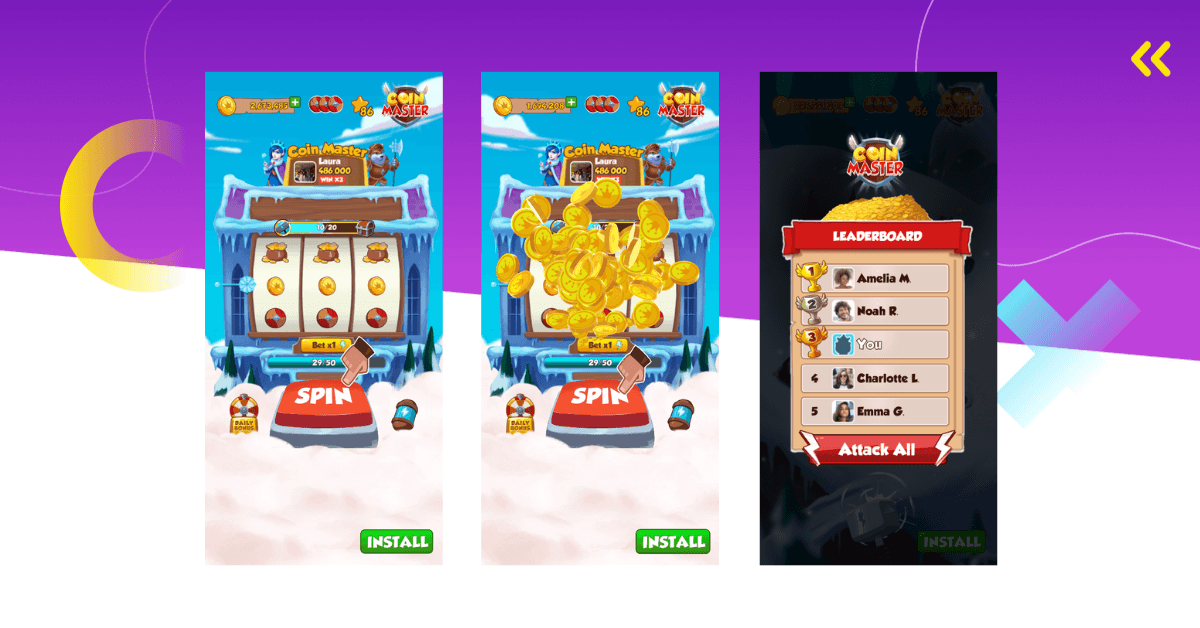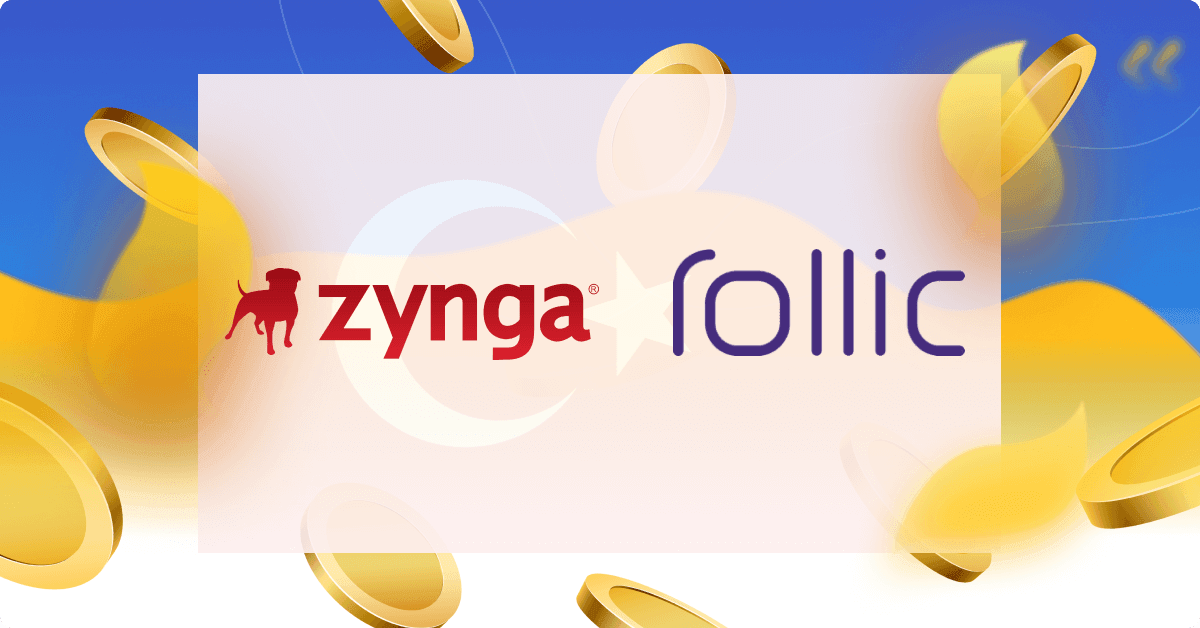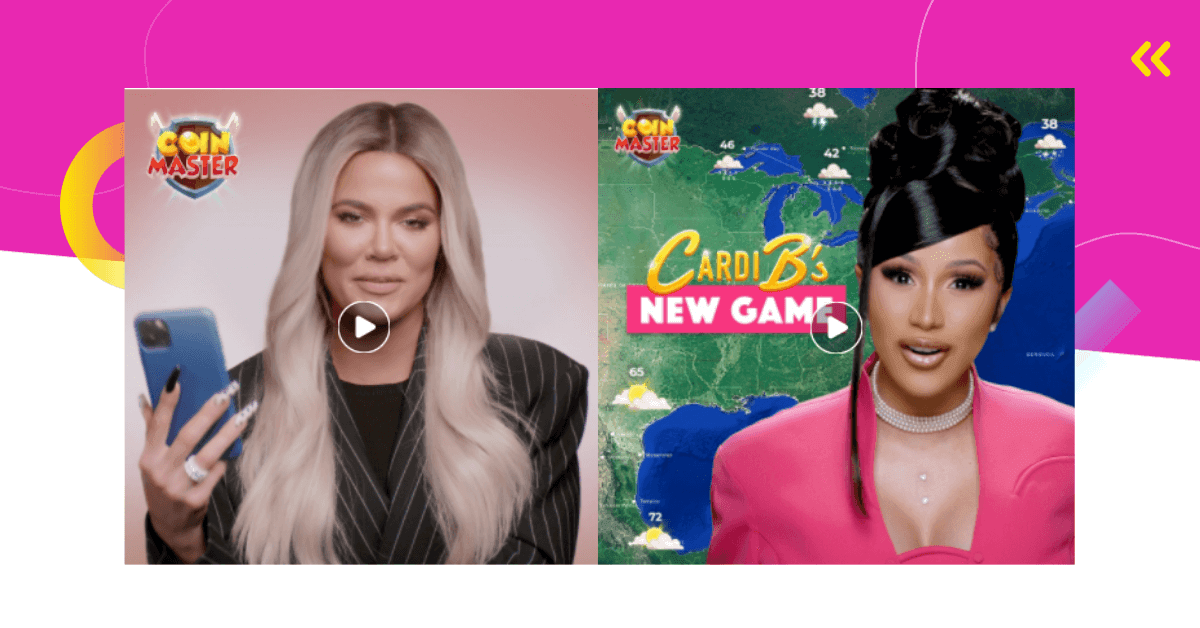Looking for an ad format that will help you get more users for a mobile game?
Let me introduce playable ads.
Even though they have not been as utilized as video ads, playable mobile game ads are known to significantly boost conversions due to their interactive nature.
Here’s why you need to make them a part of your user acquisition strategy.
What Are Playable Ads?
Playable ads are an interactive ad format that allows users to play a snippet of a mobile game before downloading it. In other words, it’s a mini-game that showcases the game’s main functionalities. Playables tend to last from 15 seconds to up to a minute.
The ability to test drive a game before deciding to install it makes playable ads more enticing than video ads or interstitial ads. For that reason, playables have been recognized as one of the most effective ad formats by industry experts.
IDC estimates that more than 50% of game developers in the US purchased playable ads campaigns (37% purchased regularly and 17% occasionally).
Types of Playable Ads
Playable ads most commonly appear as full-screen ads and can be considered interactive interstitial ads. You’ll find these types of ads on social media platforms or inside other apps.
From a technical standpoint, they’re either HTML ads or interactive videos.
HTML playable ads recreate parts of gameplay using HTML code and the game’s assets. They provide the most accurate representation of the game.
Interactive videos use game footage with HTML elements to create a playable ad. While they’re the easiest to produce, they’re not as engaging.
Advantages of Playable Ads
You’re probably wondering, “Why should I use playable ads to advertise my mobile game?”
To answer your question, here are some benefits of this ad format.
A Powerful Way to Acquire Players
As I’ve mentioned before, playables allow users to “try before they buy”. This makes them a superior ad format that has the power to convert more users than video ads.
When players engage with these fun mini-games, it drives their interest in the game and makes them want to click that install button.
Many game studios achieved incredible results with playable ads.
According to Consumer Acquisition, “Bagelcode saw a 3.2X improvement in return on ad spend on Android and a 1.4X improvement in return on ad spend on iOS using playable ads. Rovio saw a 40% lower cost per paying user and a 70% lift in day seven return on ad spend.”
Furthermore, playable ads don’t feel like ads, which is one of the main reasons for their effectiveness.
Additionally, playables are an opt-in ad format. Unlike non-skippable ads, users can choose to interact with them. This is another reason why playables tend to convert more users than other formats.
Playable Ads Result in Higher Retention Rates and LTV
When users install a game after watching a playable ad, they already know what to expect.
In other words, they’re already familiar with the basic game mechanics, which allows them to start playing right away.
That tends to result in higher user retention and high player LTV (lifetime value).
According to ironSource, retention rates can go up by 30 to 40 percent with playable ads.
Because of that, the CPI (Cost Per Install) is higher than for a video or banner ad. However, the ROI ends up being higher, which makes it worth it.
Furthermore, because users have already tried out the game before installing it, the players who might not like it are already excluded. That allows game developers to focus on engaged and interested users as well as save money in the long run.
Access to In-Ad Data for Performance Analysis
Another huge benefit of playables is the ability to access in-ad data. You can track every interaction with the ad. That helps you analyze its performance and makes it easier to optimize ad creatives.
For example, you might find that too many users are losing the mini-game and finding it too hard, which results in them not downloading the game.
This tells you the gameplay difficulty level should be slightly lower if you want to get more conversions.
Simple, right?

Disadvantages of Playable Ads
Even though playables are a highly effective ad format, it’s not all roses.
Here are some challenging aspects of this ad format you should keep in mind.
Playable Ads Are Not as Easy to Produce as Other Formats
Compared to video ads, playable ads take a bit more time and effort to produce. Furthermore, the cost of production tends to run higher. These are some of the main reasons why this ad format is not utilized more, even though it’s highly effective.
This is something to consider when thinking about advertising your game with playables.
However, using the right tools or outsourcing can significantly cut down on the time and effort it takes to produce them.
Iteration and Testing Can Be Challenging
Playable ads not only take time to produce but also to iterate and test (when doing it manually). This is another reason this ad format has not become as universal as video ads.
It has become relatively quick and easy to create a lot of variations of a video ad and test its elements. Because of that, video ads are the go-to for many game developers.
However, investing the extra time and resources into playables is still worth it, as they can produce impressive results.
To make iteration and testing easier, consider utilizing automation platforms, which will help you quickly figure out what’s working and what’s not.
Also, it’s important to note that more and more tools are available that make the iteration process simpler and quicker. Hence, we expect that this ad format will become more widely used in 2022 and years to come.

Playable Ads for (Hyper) Casual vs. Mid-Core Games
Traditionally, playable ads were thought of as an ad format that works only for casual and hyper-casual games. That’s due to the simple gameplay these genres are known for, which lends itself well to playables.
However, more and more mid-core and even hardcore titles are advertised with this ad format. This tells us that it’s possible to advertise more complex games with playable ads.
However, to do it right, you need to simplify the gameplay. Furthermore, you should choose only one aspect of the game you want to demonstrate in an ad.
Some mid-core games also use puzzle mini-games in playables, even though puzzle mechanics are not a part of the game. This accomplishes two things – it simplifies the game for a playable ad and reaches a broader audience of gamers.
The Main Elements of Playable Ads
Most commonly, playable ads consist of three main elements – a short tutorial, gameplay, and a call to action.
Tutorial
The tutorial offers a quick introduction to the main game mechanics and how the game works. It should be short and simple.
For example, a tutorial for a playable ad for a match-3 puzzle game should explain how the match-3 mechanic works. In other words, it should show players that the goal is to match three tiles to make them disappear from the board.
Also, the tutorial part of a playable ad should work as a hook. So make sure you impress viewers and get them interested.
Gameplay
The main game features and functionalities should be demonstrated during gameplay. However, unlike in the tutorial, the player interacts with the game without much guidance.
Make sure to include different game assets, animations, music, and sound effects to create a rich and dazzling experience.
Call to Action
Finally, most playables include a call to action, which is either embedded throughout the ad or appears at the end. The goal here is to invite users to download the game, which should hopefully result in a conversion.
If it’s an app install ad, users are redirected to the app store if they choose to click the download button.
Tips for Producing Playable Ads for Mobile Games
Here are some practical tips for producing playable ads to advertise a mobile game.
Keep It Simple
Here’s the thing.
Playables don’t need to represent the full game experience. In other words, you don’t need to recreate your entire game for an ad.
Instead, focus on demonstrating the gameplay experience with basic, early-game features and mechanics.
The goal is to keep it simple enough so that users can comprehend what the game is about in seconds. This is why hyper-casual games are perfect for playable ads. Other, more complex genres can be more difficult to simplify, but it’s doable.
Impress with Gameplay
Even though the gameplay in playable ads needs to be simple, it still needs to be impressive enough to get people interested in the game.
To achieve this, you need to think about how to represent your game in the best light.
Which game feature is the most entertaining? Which characters are the most fascinating? Are there riveting storylines that can make users connect with your game?
Consider all of the selling points of your game, and make sure to include them in the ad.
Break Down Gameplay for Complex Games
As I’ve mentioned, it’s slightly more challenging to produce a playable ad for a mid-core or hardcore game than it is for a (hyper) casual game.
But it can be done. Here are some tips.
The best way to go about it is to divide the core gameplay into several elements. In other words, showing different selling points with each playable ad.
For example, focusing on strategic moves, battle scenes, character selection, weaponry, and storylines. Each playable should feature one of these.
That also helps with targeting players based on their motivations for playing.
More on that in the following section.

Consider Player Motivations
As with any ad format, knowing who your target audience is and why they play mobile games will help you develop a better campaign.
Here’s how that translates to playable ads.
Let’s say you have a match-3 puzzle game with design and makeover meta-layers similar to Project Makeover.
Naturally, you would want to create a playable ad featuring the core gameplay – match-3 puzzles. It would attract casual players motivated by cognitive challenges and enjoy solving puzzles.
However, you could also produce playables that include a snippet of the meta elements. For example, one ad could let users do a simple makeover on a character. Another could be focused on designing an interior.
Both would attract a different group of players than the match-3 playable ad. They would appeal to players who are into customization and expressing themselves in games.
Include a Tempting Call to Action
After the users have interacted with your playable ad, there should be a CTA asking them to install the game. The most common ones are “Install now”, “Download free”, and “Play now”.
While you can include the CTA after the viewers are done playing, it’s better to make the download button available throughout the ad. That way, users can choose to install the game at any point.
Leave People Wanting More
As we’ve established, playables should be simple. However, they should hint at a more intricate experience that is one click away.
Use this opportunity to tease other aspects of the gameplay – this will leave people wanting more. For example, ending a storyline with a cliffhanger makes people want to find out what happens next.
Test and Iterate
To reach a wider audience and test your playable ads, you need to create dozens of variations.
Then, it’s essential to track and analyze the performance of your playable ads. As I’ve mentioned earlier, each playable ad elements (tutorial, gameplay, and CTA) are trackable. Thus, you can analyze when users perform actions like tapping, clicking, or swiping.
This will tell you how users interact with your ad, what’s working, and what’s not. For example, you might find out your tutorial is too complicated or that the CTA is not getting any clicks.
Then, you can fine-tune your playable ads.
The best way to go about it is to do A/B tests. By testing one variable at a time, like a CTA, for example, you’ll be able to identify which one gets you the most conversions.
Playable Ads Example
I’ll leave you with another example of a playable ad.
According to AppMagic, this is one of the top-performing playable ads in 2022. It’s for the casino game Blackout Bingo.
Blackout Bingo is an extremely simple game that requires no skill. It’s perfect for relaxing and passing the time. The playable ad for Blackout Bingo reflects that. The only thing users need to do in this playable is to locate and click called-out numbers. To make it even simpler, the called numbers are highlighted on the board. However, users need to be quick, which creates excitement in the ad.
What’s interesting is that, at the bottom of the screen, the ad shows how much other users have won, adding an interesting social and competitive aspect to it. Furthermore, at the end of this playable ad, players are shown how much money they could’ve won, along with a “claim now” button. The purpose of this is to entice users to download this game.
Final Thoughts on Playable Ads
Hopefully, you’ve learned more about why playable ads are such an interesting and efficient format.
But even though they’re highly effective, you shouldn’t rely solely on playables. Think of them as a great addition to your all-encompassing advertising strategy.
For more info on mobile game advertising, head to our blog.







Comments